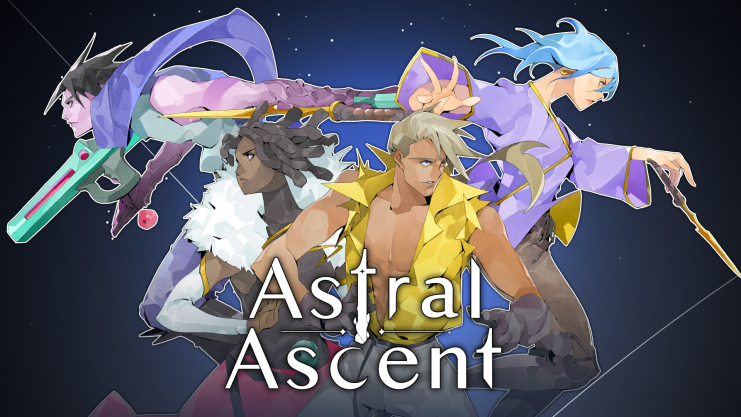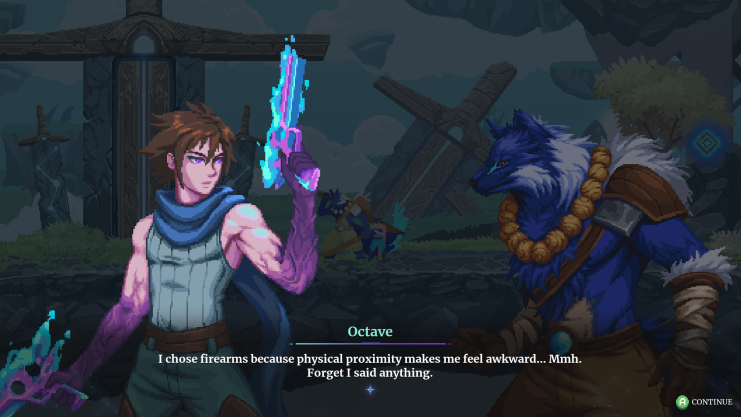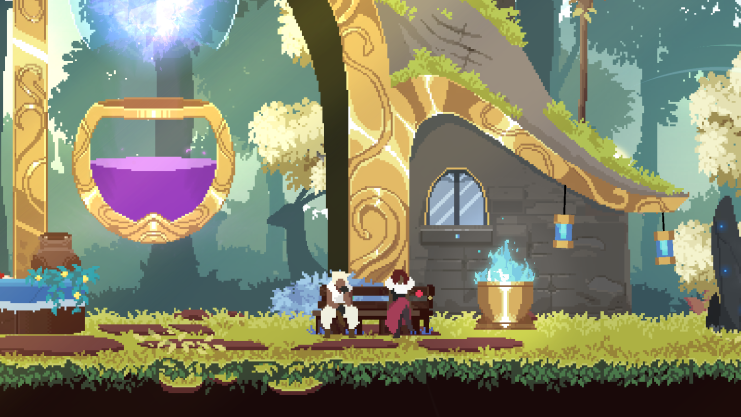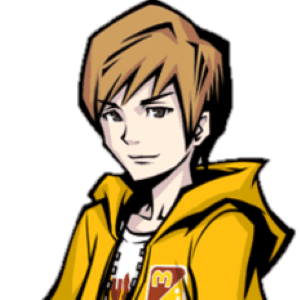Originality is something we gamers have a bit of a weird relationship with from a critical standpoint. We always claim that innovation is among the most desirable things a video game can do, yet seem all too happy to buy the next title making buzz in our favorite genres regardless how much has actually been done to change things up under the surface. Deriding the trailer of one game as a total knock-off in one breath, and foaming over the trailer of a more established or ‘cool-looking’ game with the same basic premise the next. It is this peculiarity of our subculture that comes to mind when I consider today’s featured game, as it not only tackles one of the most done-to-death genres around but also draws some major parallels to the indie game which propelled said genre into arguably the peak of its popularity. Can it escape the shadow of its inspirations or will it remain mere flattery? It’s time to find out!

Developed and published by Hibernian Workshop and released in November of 2023, Astral Ascent is your superstitious mid-20s suburban girlfriend’s favorite roguelite, available on PS4, PS5, Nintendo Switch, and PC. Its premise involves a variety of characters trapped within a strange interplanetary prison seeking the head of its jailer by fighting through hordes of monsters and the twelve constellation-themed guardians who bar the way. Players interact with the game by navigating platforming courses, battling enemies, collecting randomized upgrades that disappear on death, making permanent upgrades at a hub area, and talking to various NPCs. Please note that I played the Steam version of the game for this review. Also worth mentioning is that I’ve played this game since some of its oldest Early Access builds, and I will make some criticisms based on my knowledge of how the game developed.
The story of Astral Ascent takes place in a mystical prison among the cosmos, and centers around a variety of characters but the de facto protagonist is named Ayla. The prison, known as The Garden, is essentially the trophy room of an interplanetary tyrant, and Ayla begins the game by breaking into this Garden with the hopes of defeating this tyrant and restoring peace to the galaxy. From there the story is told in bits and pieces as you meet different conditions, such as talking to different NPCs, playing with the different characters you unlock over the course of the game, finding lost memories, and encountering one of the 12 Zodiac bosses during a run. On its own I think the story on offer is pretty decent all things considered, as the lore drip-feed usually pays off with interesting interactions or illuminating background details that really bring the various characters to life. There is something mildly dull about the fact that the tyrant is the only true villain in this story so that the Zodiac guardian system can make sense, but I can mostly forgive it since this setup leaves more room to explore the game’s bonkers setting.
Where I think the game struggles the most narratively is in what was changed from beta to full release. While these problems might not be terribly overt to the average player they are impossible for me to unsee. Ayla herself was actually a far gentler character back when part of the initial premise was that The Garden’s residents had lost their memories, and while that gentleness might have come across as a little odd for an assassin it actually gave her a personality niche that distinguished her from the other protagonists. In the final version she feels too similar to fellow protagonists Calie the architect and Octave the mage-gunner in particular, which is a real shame. Speaking of Octave, he is the character who was muddied the most by the release, because originally he was going to be the character who broke into The Garden of his own volition on his quest for revenge. Now that Ayla took that role from him, Octave just feels like an especially bitter prisoner and it makes the other characters’ chastisements of his vengefulness feel weird considering that, angry or not, he’s still working towards the same end goal as most of the protagonists. Indeed revenge is a destructive desire and the other characters are technically correct in criticizing him, but it made so much more sense when the context behind these conversations was that he literally put himself in the prison to enact revenge and the tension inherent in his relationship to those who were genuine prisoners. It doesn’t help that this change opened a plot hole where despite every other character respawning at the haven when they die in The Garden, Octave’s mother was apparently killed permanently? But I digress; on the whole Astral Ascent has merit in its fragmented storytelling that’s fun to piece together while you make your escapes, but there are weird inconsistencies and short-sighted changes that hold it back from achieving all that it could have.

As for the gameplay, Astral Ascent is a action-platformer roguelite with a very simple structure: pick your character, battle through four areas while collecting power ups, fight bosses while trying to reach the final one, go back to the beginning if you die, repeat until you clear the game. That’s all well and good, but there are a few notable additions this title adds to the formula that are worth discussion. The game’s basic structure finds its roots in the 2d platformer genre, where many of The Garden’s challenges are navigated through a wealth of basic platforming segments called Exploration Rooms. These rooms are taken from a preset list of configurations and don’t typically ask much of the player outside of dodging a few obstacles, but I liked how they give the game a meaningful alternative to pure combat rooms. Exploration Rooms still feature plenty of combat yes, but there’s way more incentive to play around with interactive objects and terrain to get the upper hand. Combat itself is an affair of landing basic hits to replenish a mana gauge which allows you to cast powerful spell attacks, all while timing jumps and dodges to avoid enemy retaliation. The key which makes Astral Ascent’s battles enjoyable is also the thing it inherits the most from the platformer genre: movement. The heroes are light on their feet and feel great to maneuver around the battlefield, and the controls are perfectly responsive. This allows the game to feature hectic battles and especially boss fights which sometimes feel like they cross into bullet-hell territory, yet it always leaves even lower-level players with a sense of control that allows them to engage with the battle system and learn quickly.
Of course the full picture of combat is incomplete with mentioning spells in more depth, and so I shall. Spells are collectible special moves that you hold exactly four of at all times, and they represent the main means of diversifying each escape attempt. They cost different amounts of mana to use, and largely feature more powerful attacks but can also do things like deploy turrets or give invincibility frames. Spells can also be upgraded with pickups called Gambits to grant them additional effects, and each spell has an affinity which encourages you to add Gambits of particular types like fire, poison, etc. But despite the huge variety that comes in selecting different spells and affinities, that’s not even the main part about what makes them so engaging over multiple runs. In truth the best part of the spell system is that you cannot recast your spells until you have used all four of the ones in your arsenal. This creates a huge dynamic to the way the game is played, which is full of endless nuance. You may like picking a 3-mana spell for its powerful effect, but if you ever find yourself in a situation where you need to cast it to get your other spells back, you might have to move into a risky position to land basic attack hits just to regain access to your full repertoire. This of course may encourage you to simply cast it earlier in your rotation, but then again you may intentionally want to cast it later because it combos nicely after another spell you’ve acquired. Considerations like these are what truly give this combat system its magic (pun intended), and I’m impressed at just how calculated the game’s core loop is underneath all those chaotic visual effects.
The act of preparing for a run doesn’t feature anything too fancy, as the main hub mostly features facilities to buy permanent upgrades or new spells for the random pool. There is of course one thing you can do here that is not a genre staple: bring a friend along! The large number of protagonists in Astral Ascent isn’t just for mere run variety, but also so that you can play it with one other person. This mode also features a revive mechanic which allows you to return your buddy to the fight if you bodyguard their unconscious body for a few seconds, which may sound like an exploit until you remember that the boss hits 75% of the screen at once and you can’t afford to stay still without paying in HP. I will admit this mode is probably more unstable than the single player mode, as it was during a co-op run that I encountered a hilarious bug where using a spell with invincibility frames caused me to gain full invincibility until the end of a room and allowed me to quite unfairly get my first clear of DL0. I also encountered a bug where Kiran’s counter-punch simply didn’t unleash the punch, though we could still get value out of it through the right upgrades. Still, the multiplayer is a lot of fun and makes this game a great option if you’re looking for a co-op title in the roguelite genre.

I’m sure there are other facets of the game I could talk about but if I tried to go over everything I’d probably have to delay this review until the end of the year. Since launch a ton of new features have been added such as better clarity tools for tracking stat buffs, a PvP mode that co-op players can play in the middle of a run, most recently a weapon system which effectively triples the amount of movesets in the game complete with a quest system to unlock even further customization, and they still have a DLC character and a new game mode to go! Rest assured that the game is very content rich and will only have more to offer by the time it’s done releasing. There could be an argument to be made that many of these additions dilute the game’s difficulty insofar as they make getting the true ending easier, but I’m alright with it since the post game difficulty levels more than make up for it.
As for the presentation of the game, Astral Ascent is an amazingly well polished pixel art game. The in-game sprites are near perfection, blending readability with detailed and complex animation cues that keep themselves easily identifiable no matter the situation. Every enemy from the littlest grunt to the biggest, baddest Zodiac has thoughtful and clear animations to help players learn their patterns. My favorite part of the visual presentation has to be the backgrounds though. The grand expanses of The Garden’s many biomes are full of gorgeous and fantastical vistas that really draw me into the world even as I focus on surviving. They are truly the unsung hero of the presentation. If I had any one complaint about the visuals, it would probably have to do with the character designs. Now don’t get me wrong, the character portraits for the dialogue sections are excellently drawn and blur the line between pixel art and higher definition styles quite convincingly, and I am in no way taking away from the incredible work that went into them. That being said, I do think the character designs in Astral Ascent end up in the territory of “too appealing for their own good,” and while I am incredibly aware of how dangerous it is to claim this given the recent internet firestorms surrounding sexy video game character design I promise this is not about uglifying games for political ends.
There is no hiding just how attractive the characters in this game were designed to look. It’s clear that when Hibernian Workshop was making their Greek astrology themed roguelite they looked at the very popular Greek mythology roguelite, noticed that the internet was unfathomably taken by the sexy character designs, and understood the assignment. While they were certainly free to employ this creative decision, I think it ultimately hurt the game’s ability to communicate through the language of character designs. To give an example, the bosses of the crimson highlands are intended to be a collection of different artificial life forms and Aquarius is no exception. His appearance as a blue giant with massive muscles and an alien-looking helmet might in theory be trying to impart a sense of monstrosity by using an unnatural color choice and preying upon our archetypal conception of evil giants brimming with power. However when you consider that the vast majority of male characters in the game such as Kiran, Taurus, and Leo have been using musculature to communicate physical attractiveness as much as physical power, and that other characters such as Ikki and Sova have probably acclimated the player to be more at ease around less human appearances, most of Aquarius’ traditionally monstrous qualities simply aren’t primed to feel as such by the time you first meet him in the later parts of the prison. For all we know at this point, underneath that helmet is a blue Keanu Reeves or something. I really think it’s a shame because the voice acting and memory fragment background stories occasionally give the cast some surprisingly interesting lore, but this lore simply doesn’t shine through visually on account of this incessant need to make every character so darn appealing. At the end of the day the visuals of the game are still very impressive, but there are areas where I think the visuals could have taken more risks in order to sell the game’s ideas much better.

But of course no discussion of the presentation is complete without talking about the music, and Astral Ascent turned out to be a quiet champion in this regard. The game goes for an orchestral soundscape which is always a plus in my book, but rather than using it for grandiosity the OST instead opts for a surprising amount of gentleness. The soft strings accentuated by some supportive brass gives the whole collection of music a soothing effect which perfectly accentuates the dreamlike nature of the world it is accompanying. Even the battle tracks add just the right amount of tension to get you in the zone without breaking the enchanting feel of the rest of the music. Perhaps others might find the relaxing vibe of the score to be at odds with the action combat, but as someone who uses classical music to stay calm while driving I think it has a similar effect of helping the player focus on the tough challenge in front of them. Definitely give the score a listen, it might surprise you!
As for the spiritual content of the game, first I should allay any worries about the game’s astrological theming by saying no, it doesn’t actually feature any horoscopes or such superstitions. The game does have you set your star sign when you first boot it up (and can be changed at any time), but all this does is cause the Zodiac of the same name to occasionally do nice favors for you like handing out a special treasure chest or being very likely to become your guardian if you speak with them at the bar. If anything a smart player will swap star signs constantly to manipulate the game into getting them builds they want easier. If you’re worried about the game creating too much interest in the subject of astrology then you’re certainly free to pass it by, but on its own it really is just theming. As for whether we can learn anything from Astral Ascent in relation to our spiritual journey towards Heaven however, I do find myself at a bit of a loss for ideas. There are certainly related themes to be found like the will to persist in the face of a difficult journey inherent in roguelites as a whole, but when I dwell on the central narrative however there’s a certain static element to the vast majority of the cast which I struggle to read anything fully insightful out of.
The narrative framework of defeating the tyrant could certainly be read as a battle against a manifestation of our sinfulness or the devil, sure, but with the exception of perhaps Octave the cast doesn’t really seem to grow as a result of the narrative’s progression. Even if they do grow, said growth only seems to happen after the story ends in one of the many collectible pieces of the epilogue you get by beating the true final boss with different combinations of protagonists and Zodiac guardians. Consequently this holds the game back from any easily grasped spiritual message, because it completely externalizes the source of conflict out to the tyrant when true spiritual warfare takes the will to battle the darkness within as much as the darkness without. There can of course be stories where the hero is a paragon and the real problem lies without, but such heroes are often characterized by virtues nurtured in self-sacrifice and the will to protect the good, rather than merely being a blunt instrument of evil-vanquishing. The fact that Astral Ascent seems to neither test nor critique the character of most in the cast smacks of a naive outlook on human nature, and in some ways reminds me of other attempts to overly externalize the source of our suffering such as Liberation Theology. The game is certainly still a good time and I doubt it would be a corruptive experience when approached properly, but just remember that the true slayer of tyrants is one who has first slain the tyrant in his heart.
In conclusion, I found Astral Ascent to be a very fun take on the roguelite genre with lots to offer. Its admittedly interesting world is undercut by a lack of growth in several of its principle characters and some of its artistic design can come across as a little shallow, but it’s incredibly well thought-out game mechanics combined with some of the most captivating animation, environments, and music I’ve seen in an indie game far outweigh these negatives. I can say with certainty that the game did not settle to copy its inspirations but thoroughly strove to improve upon them, and personally I think it was successful for the most part. If you’re not yet over the roguelite craze of the past few years then this is an excellent option for those looking to scratch that itch, especially if you enjoy co-op games. I guess I can only wait patiently to see just what final surprises this game has in store for its last few updates… or just keep working on beating DL7 and beyond in the meantime!
Scoring: 90%
Gameplay: 5/5
Story: 3/5
Art and Presentation: 5/5
Music: 5/5
Replayability: 5/5
Morality/Parental Warnings
Astral Ascent’s main point of concern is its use of popular Greek astrological names and concepts as a framing device for its boss characters, straight up known as Zodiacs. These connections mostly just draw upon the broad personality associations made with the star signs, and don’t actually feature any horoscopes within the game. You are required to pick a star sign in order to receive bonuses from one of these Zodiacs, but that’s pretty much the extent of involvement with that mechanic. You are of course free to find the mere association to star signs distasteful if you wish. Beyond that the game’s main fighting mechanic involves collecting and upgrading “spells”, although so little genuine magical iconography is associated with them that you could probably call them “abilities” and nothing would change fundamentally.
The tyrant villain of the game has probably killed countless people in his conquests and most of the characters in the game could be said to be prisoners of war. Some existential themes are associated with the artificial zodiacs of the crimson highlands. Octave’s mother is implied to have been at least somewhat abusive, but then again what else do you expect from a witch? Ordan’s memory fragments associate her with themes of selfish divorce and abortion, albeit the latter might be a fake-out thanks to a hidden platform in the hub-area. Virgo and and Libra’s endings feature same-sex “marriage” and assisted suicide respectively. Character design can often be quite sexualized, with the male characters in particular sporting a lot of exposed torso. Some foul language appears in the game, albeit not super frequently all things considered.
